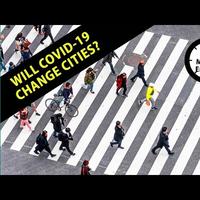Will Covid-19 change cities? 6 Minute English - YouTube
Hello. This is 6 Minute English from BBC Learning
English. I'm Neil.
And I'm Rob.
From the bubonic plague to cholera and
tuberculosis,
disease and pandemics have changed the way
cities have been built. For example, buildings
in 19th century Paris were designed with large,
high-up windows to allow plenty of sunlight.
They were supposed to stop the spread of
tuberculosis.
Coronavirus has been no different. In
lockdown, cities from Rio to Barcelona
were transformed as wildlife and
birdsong replaced the noise
of taxi horns and traffic. And with no car
pollution you could even see the stars at
night!
In this programme we'll be asking if cities
after lockdown will ever be the same again
– and if we want them to be.
We'll be hearing some ideas from different
cities around the world.
And of course we'll be learning some new
vocabulary along the way. One of the cities
most affected by Covid-19 was Mumbai in India
– but approximately how many people
were affected? What's the estimated
population of Mumbai? That's my quiz
question for you today Rob. Is it:
a) 15 million people?
b) 20 million people? Or,
c) 25 million people?
I know Mumbai is an international mega-city
so I'll say b) 20 million people.
OK, Rob, we'll find out later if that's
right. Now, Beatriz Colomina is a
professor of architecture at Princeton
University in
the United States. She's spent years
researching the relationship between
cities and disease.
Here she is talking with Kavita Puri,
presenter of BBC World Service
programme, The Inquiry:
Take tuberculosis. Unlike cholera, which was
eliminated in London by re-designing the sewage
system in the 1850s, TB was airborne.
It became a real problem with the rise of
the industrial cities, the metropolis, before
an antibiotic was effective.
One in seven people on the planet had TB,
but in dense cities like Paris, it was one
in three. Closely packed tenements meant the
disease spread like wildfire and architects
and planning experts responded.
Some diseases, like cholera, could be
prevented
by redesigning cities to improve hygiene,
like the waste water sewers in 19th century
London. But the problem with tuberculosis,
or TB for short, was that the disease is airborne
– carried and spread in the air.
Adding to the problem was the fact that
antibiotics – medicines like penicillin that
can destroy harmful bacteria or stop their
growth – was not discovered until 1928 –
too late to save the thousands of people
who died in Mumbai,
New York, Paris and other cities during the
1800s.
Diseases like TB killed more and more people
as cities industrialised and grew bigger and
bigger, leading to the creation of the
metropolis – the largest, busiest and
most important city in a country or region.
Many people crowded together in large
metropolises
meaning that disease could spread like
wildfire – an idiom meaning spread
quickly around many people.
Even today disease is shaping our cities.
In post-Covid Paris, new ideas for a '15
minute city' aim to make all public
services available within a fifteen minute
walk to help people working from home.
Other countries want to build better, more
affordable housing outside the city centre.
But according to Mumbai resident
Dr Vaidehi Tandel this won't work – even
if the housing on offer is better. But why?
The reason is work.
When you shift them out, you're moving them
away from their livelihoods and they're
not going to be able to sustain themselves
there so they will be coming back
because their jobs are in the city and they
cannot afford the commute from further
off places.
Dr Vaidehi Tandel there, talking on the BBC
World Service programme The Inquiry.
Trying to make cities less crowded is one
way to minimise the risks from disease.
But moving people away from the city
centre means moving them away from
their livelihood – their job or other way of
earning money to pay for
food, housing and clothing.
Many people still want to live near their
workplace in the city centre because they
can't afford to pay for the commute – the
journey between their home and their
place of work.
Which is real problem when you live in a
city of… how many people did you say live
in Mumbai, Neil?
Ah yes, in our quiz question I asked you what
the estimated population of Mumbai is.
I said b) 20 million.
And you were absolutely right! Around 20 million
people live in the Mumbai metropolis, making
it very difficult to socially distance.
In this programme we've been discussing
the relationship between cities and disease.
In the 1800s, tuberculous, or TB, killed thousands
because it was an airborne disease – spread
in the air, and hard to prevent.
Antibiotics – medicinal chemicals like
penicillin which can destroy harmful
germs, couldn't help because they weren't
discovered until decades later.
So in metropolises – the largest and most
important cities, where people live crowded
close together, diseases spread like wildfire
– an idiom meaning spread widely and quickly.
In Mumbai and other places, the problem remains
that many people need the city for their livelihood
– job or other way of earning money.
So they prefer to live in the city centre
instead of paying for the daily commute – a
journey, often by train, bus or car, from
your home to your workplace.
That's all we have time for in this programme, but remember
you can find more useful vocabulary, trending
topics and help with your language learning
here at BBC Learning English. Bye for now!
Bye!

